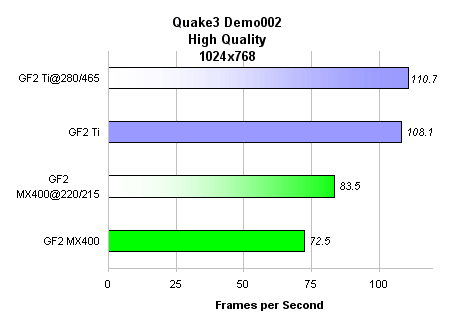|
Performance
Comparison
The
Geforce2 MX400 vs. The Geforce2 Ti
by Mark
Rubrico

Frames above Everything Else?
Insanely
high frame rates may very well prove to be useless to
most people. Specially when you are averaging well beyond
a hundred frames per second and consistently getting
very high minimum frame rates. Excessively high
frame rates are practically useless.

For
example, at 1024x768x32bit on the High Quality Setting
of Quake3, the MX400 is performing very admirably! Averaging
well over 60 frames per second, the MX400 is performing
20% faster than what some people ( HARDCORE GAMERS )
consider to be the acceptable frame rate. Some people
( avid gamers ) aren't able to differentiate a game
running at 60 frames per second to a game running at
30 frames per second!
Running
games at 1024x768 ( and 32 bit color depth ) is slowly
becoming the standard nowadays. This resolution is what
most people consider the "sweet spot" to run
there games on. Running at resolutions above 1024x768x32
wont make much difference for most people, who dont
own very large monitors ( 19+ inches )
Considering that MX400 delivers more than enough frames
per second when running Quake3 at 1024x768x32, suddenly
makes the Geforce2 Ti a very unattractive product, price
wise. Why pay more than twice the price for the Ti,
when it will deliver an unnoticeable ( overclocked MX
83.5 fps, Geforce2 Ti 108.1 fps ) increase in performance
over the MX400. ( at these settings, games, resolution
and platform ).
Full
Screen Anti-Aliasing ( FSAA )
When
playing at a relatively low resolution, it is sometimes
not too difficult to notice that lines ( diagonal )
exhibit a staircase effect. This is caused by the lack
of number of pixels to represent a line. Cranking up
the resolution somewhat lessens the effect. But surprisingly,
even at 1600x1200 aliasing of those "jaggies"
are still noticeable!
There
are many ways to rid lines of those jaggies. With the
Geforce, Geforce2 line of cards Nvidia uses what is
called "supersampling". This is done by rendering
a scene at 2x or 4x its resolution, and then bringing
it back to the original resolution. Some sort of blending
( really averaging of subpixels color values ) is performed
on adjacent pixels to effectively smoothen the line.
To better illustrate this effect, here are some screen
shots from Quake3 demo. ( the F11 button was used on
Quake3 )

It is
very clear on the series of screen shots taken that
the jaggies on the statue's arms back and hair are removed
through anti-aliasing. The 2X FSAA setting dramatically
improves the picture quality of image. And the 4x FSAA
further reduces the jaggies to the point that they are
barely noticeable anymore. This shots were taken at
1024x768x32.
As with
everything else, FSAA comes with a price. Since rendering
at 2x and 4x effectively doubles and quadruples the
number of pixels rendered on the chip ( fillrate and
bandwidth limitations are amplified ) , a tremendous
performance drop can be expected. Yes, FSAA looks good,
but how much penalty
are we talking about here. Let's move on.
Next :
Full Screen Anti-Aliasing
|


